Lost Railway Stations of Romney Marsh
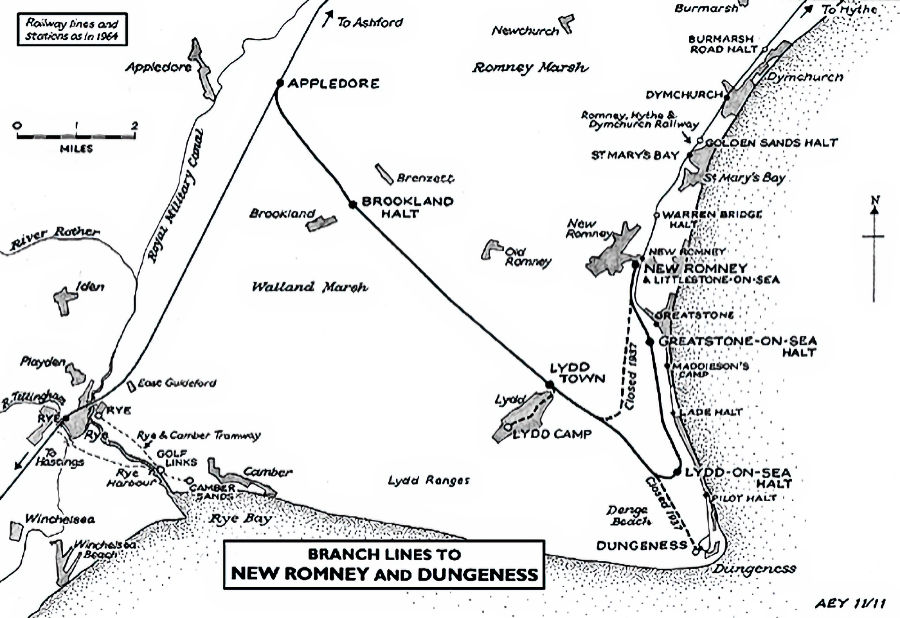
Railway lines and stations as in 1964 (Ack. 51)
The Lydd Branch of the South Eastern Railway opened between Appledore and Lydd on 7 December 1881, having been promoted to develop a new harbour for cross-channel shipping services. Leaving the Ashford to Rye line at Appledore the route went via Lydd to Dungeness, then turned north to follow the coastline to New Romney.
As so often happened with ambitious railway promotions, the cross-channel port never materialized.
Dungeness also saw goods services commence on 7 December 1881 but passenger trains didn't run until 1 April 1883. There was just one other station, at Brookland. The branch was notable for the large number of level crossings it possessed; twelve along the relatively short route of about eight miles! The continuation to New Romney opened on 19 June 1884 with trains needing to reverse at Lydd to go to both the stations at New Romney and Dungeness, therefore calling twice at Lydd.

The Lost Railway Stations
Brookland Railway Station was located just off the A259 road between Brookland and Brenzett. The building stills exists today as a private residence.
Brookland was the first station on the Lydd Railway Company's New Romney branch line. It opened to traffic on 7 December 1881. The station was ½ mile from Brookland village, Brookland was once an impressive station boasting two platforms, with the main station building on the downside and a small wooden waiting shelter on the upside. A passing loop was also provided, but this was removed in 1920.
As passenger traffic dwindled and freight became insignificant in the post-war period, the New Romney branch fell into decline and subsequently figured in the Beeching Report along with the Ashford to Hastings line. Although the closure was protested against, passenger services ceased on 6 March 1967, with the section between Romney Junction and New Romney closing entirely. The line was retained for goods traffic to Dungeness Power Station
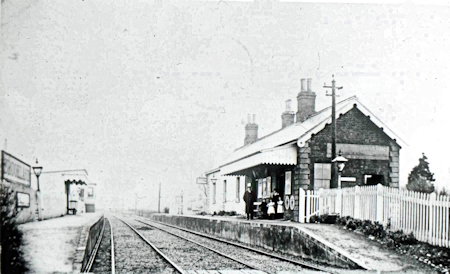
Brookland Railway Station c1925
The station building remains as a private residence and the down platform remains extant if overgrown; the up platform has been partially covered in soil and is heavily overgrown. The line through the station remains open for freight traffic and is subject to a 20 mph speed restriction. The level crossings are unmanned and have to be operated by the train crew. The line sees regular nuclear waste traffic from the Dungeness Nuclear Power Stations.
![]() Reference and more information - Wikipedia
Reference and more information - Wikipedia
![]() Reference and further information - Disused Stations
Reference and further information - Disused Stations

Opened in 1883 by The Lydd Railway Company, it closed to passengers in 1937. Dungeness was the terminus of the Lydd Railway Company's branch from Appledore which opened on 7 December 1881. Passenger services initially terminated at Lydd, although a goods service operated as far as Dungeness. The line was opened throughout to passengers as from 1 April 1883.
The railway terminated almost at the foot of Dungeness Old Lighthouse where very basic facilities were provided in the shape of a single platform on which was perched a small arched roof weather-boarded shed comprising a ticket office, waiting room and ladies and gents toilets. A run-round loop was provided to facilitate engine reversals and a siding led to the lighthouse.
The promoters of the line had hoped that linking Dungeness, one of the largest expanses of shingle in the world, with London by rail would lead to its development as a port from which cross-channel steamers could operate to the small French fishing port of Le Tréport, 60 miles distant and 114 miles from Paris.
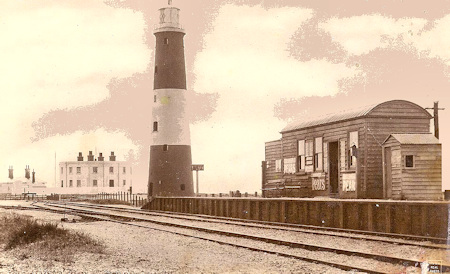
Dungeness Railway Station
Proposals to construct a harbour at Dungeness had been around since the 1870s and received support from South Eastern Railway chairman Edward Watkin; the inexhaustible supply of shingle could, if dug out, have been used for track ballast and to form the basin of what could have been one of the most cheaply built dock systems in the world.
The development of Dungeness failed to materialise and the South Eastern Railway, which had taken over the Lydd Railway Company in 1895, was left with a short branch lines in a remotely populated area, with the Dungeness branch carrying the lightest of traffic; shingle did provide some traffic, including flints for the Potteries which used them to provide glaze on china. The line survived for a further fifty years but finally closed to passengers in 1937, leaving it open for goods until May 1953. To make up for the closure of Dungeness, the Southern Railway opened a new station at Lydd-on-Sea (½ mile away) whose running in board read "Lydd-on-Sea (for Dungeness)".
![]() Reference and more information - Wikipedia
Reference and more information - Wikipedia
![]() Reference and further information - Disused Stations
Reference and further information - Disused Stations

Greatstone-on-Sea station - really just a halt- was located at the west end of Baldwin Road, where the primary school car park is located today. The station came about in 1937 when, in response to holiday camp development in the area, the Southern Railway decided to realign its branch line to New Romney (which had been opened in 1884) closer to the sea and to open two intermediate stations - Lydd-on-Sea and Greatstone-on-Sea.
Greatstone was convenient for Greatstone Camp and Maddieson's Holiday Camp and competed with services provided by the Romney, Hythe and Dymchurch Railway (RHDR) which had already been operating in the area for a decade.
The station was equipped with basic facilities consisting of a long single platform on the upside with a simple shelter. An extensive concrete forecourt was, however, provided for the coaches which were expected to ferry in crowds of holidaymakers.
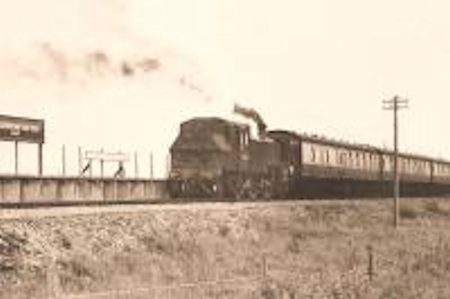
Greatstone-on-Sea Railway Station c1960
The failure of Greatstone to develop into a substantial holiday resort, coupled with the inconvenient siting of the station by comparison with the RHDR's Greatstone Dunes and Romney Sands stations, led to it being downgraded to an unstaffed halt in 1954. As passenger traffic continued to dwindle and freight became insignificant, the New Romney branch fell into decline and was listed for closure in the Beeching Report. In 1966 the Minister of Transport Barbara Castle announced her intention of closing the Appledore to New Romney Branch and passenger services ceased on 6 March 1967.
Although the trackbed from Romney Junction towards New Romney is easily traceable, nothing remains of Greatstone-on-Sea Halt today except for the concrete forecourt, which is used for parking, and a slightly raised area of ground where the platform once lay. The platform was demolished in the 1980s and an access road to a school car park crosses the platform area.
![]() Reference and more information - Wikipedia
Reference and more information - Wikipedia
![]() Reference and further information - Disused Stations
Reference and further information - Disused Stations

Prompted by holiday camp development in the area, the Southern Railway decided in 1937 to realign its branch line to New Romney (which had been opened in 1884) closer to the sea and to open two intermediate stations - Lydd-on-Sea and Greatstone-on-Sea. The opening of Lydd-on-Sea on 4 July 1937 coincided with the closure of Dungeness station to passengers; it was intended that Lydd-on-Sea, ½-mile from Dungeness, would serve both locations and its running in board read "Lydd-on-Sea (for Dungeness)".
To handle the expected flow of holiday traffic, the station was equipped with a long curved island platform with a passing loop on which was perched a small wooden shed. The traffic never materialised and the station was downgraded to an unstaffed halt on 20 September 1954 when its passing loop was also lifted. As passenger traffic dwindled and freight became insignificant, the New Romney branch fell into decline and was listed for closure in the Beeching Report. In 1966 the Minister of Transport Barbara Castle announced her intention of closing the Appledore to New Romney Branch and passenger services ceased on 6 March 1967.
Although the trackbed from Romney Junction towards New Romney is easily traceable, nothing remains of Lydd-on-Sea Halt today except for a gated concrete approach road from Kerton Road. The island platform was demolished at some point after 1983.
![]() Reference and more information - Wikipedia
Reference and more information - Wikipedia
![]() Reference and further information - Disused Stations
Reference and further information - Disused Stations
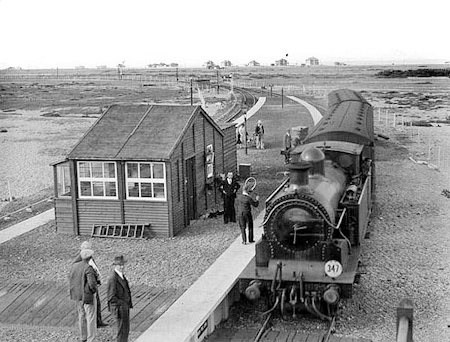
Lydd on Sea Railway Station c1952 (Ack 51)

Lydd, situated 7 miles (11 km) from Appledore, was the principal station on the line, with a considerable goods yard and a long siding to the nearby military firing range (Lydd Ranges) via the 6-mile (10 km) Lydd Military Railway (1883 - c1926). The approach to Lydd from Brookland saw the line travel over nine level crossings before passing under the line's sole overbridge carrying the B2075 Station Road, before reaching a final level crossing just before the station. The station had two platforms as well as a passing loop and a signal box on the downside.
Following the opening of the Romney, Hythe and Dymchurch Railway in 1927, the extra holiday traffic generated persuaded the Southern Railway (who had taken over the line upon the railway grouping) to realign its branch to New Romney by moving it nearer to the sea and opening two new halts - Lydd-on-Sea and Greatstone-on-Sea - in 1937. The opening of Lydd-on-Sea Halt led to the renaming of Lydd station as "Lydd Town" to avoid any confusion. The station closed on 6 March 1967 in the face of dwindling passenger traffic and insignificant freight returns, although the line remained open through Lydd Town as far as a siding near Dungeness for freight traffic to serve the BNFL nuclear power plant at Dungeness.
![]() Reference and more information - Wikipedia
Reference and more information - Wikipedia
![]() Reference and further information - Disused Stations
Reference and further information - Disused Stations
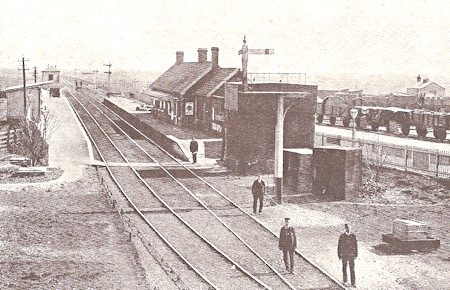
Lydd Town Railway Station c1900

New Romney & Littlestone-on-Sea
The station was opened by the Lydd Railway Company on 19 June 1884, the first day of passenger services on its 3-mile branch to New Romney from its existing line between Appledore and Dungeness.
At the time, a Victorian block of houses and hotels had been constructed in Littlestone-on-Sea in the hope of creating a seaside resort.
Both railway branches were served by the same train from Appledore; in some cases, it went to either New Romney or Dungeness, in others, passengers for New Romney were left at Lydd while the train proceeded to Dungeness with the Lydd stationmaster who would sell tickets to passengers alighting there. The train then returned to Lydd, dropped the Dungeness passengers there, and transported the New Romney passengers to their destination.
The service to New Romney in 1905 comprised eight-weekday departures from Appledore - four exclusively serving New Romney and four serving New Romney and Dungeness. There was a single Sunday working to New Romney.
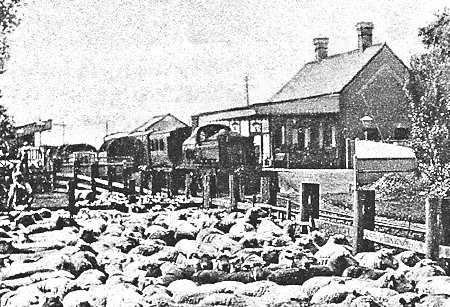
New Romney & Littlestone Railway Station
New Romney and Littlestone station, which had the suffix on-sea added in 1888, was a small two-platformed terminus equipped with an equally small goods yard. The main station building was located on the down platform, while the goods shed was just to the south-west behind the platform together with coal wharves, an end loading dock, a water tower and other small buildings.[4] In later years the up platform was hardly used other than as a livestock loading dock. In 1927, one of the sidings was extended across the road to deliver coal to the depot of the newly opened Romney, Hythe and Dymchurch Railway (RHDR) which was to open its own New Romney station here.
In the 1920s the long-awaited seaside development began in earnest. The Southern Railway (which had taken over the line upon the 1923 railway grouping) realigned the New Romney branch nearer the coast in 1937 and provided two intermediate stations - Greatstone-on-Sea and Lydd-on-Sea. However, the Southern had been slow in reacting to the coastal development and the RHDR had already been operating from more conveniently sited stations for the best part of a decade. Furthermore, the pattern of services remained more or less the same until 1952 when it increased to nine services from Appledore to New Romney (including two through trains from Ashford), and four services on Sundays from Ashford. In addition, two direct services from Charing Cross were laid on for summer Saturdays.
Following the electrification of the line to Dover in 1962 and the prohibition of steam on South Eastern metals, the New Romney branch was served by diesel-electric sets with either six-car or three-car units. Although through services from Charing Cross ceased, services remained relatively regular with nine departures from Ashford and two from Appledore on weekdays. The New Romney branch was listed for closure in the Beeching Report but survived until the Minister of Transport Barbara Castle announced her approval to close the Appledore to New Romney Branch and passenger services ceased on 6 March 1967.
![]() Reference and more information- Wikipedia
Reference and more information- Wikipedia
![]() Reference and further information - Disused Stations
Reference and further information - Disused Stations

Romney, Hythe & Dymchurch Railway
The RH&DR opened to traffic in 1927 as a 15" gauge (⅓ full size) fully working steam railway covering the eight miles from New Romney to Hythe. In 1928 the railway was extended southwards from New Romney through Greatstone to Dungeness, but it was reduced to a single track in 1947. Find out more
The photos below are of three stations on the RH&DR that are now gone.
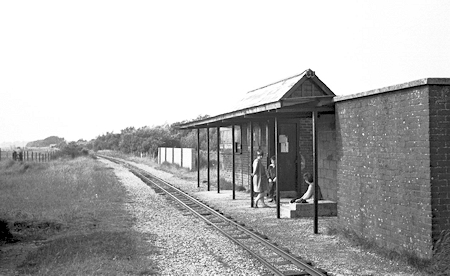
Greatstone Halt 1968
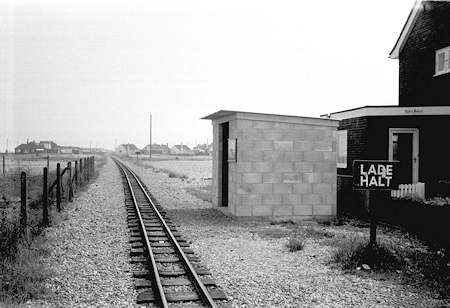
Lade Halt 1968
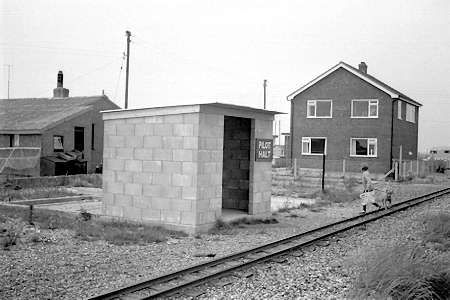
Pilot Halt 1968



















